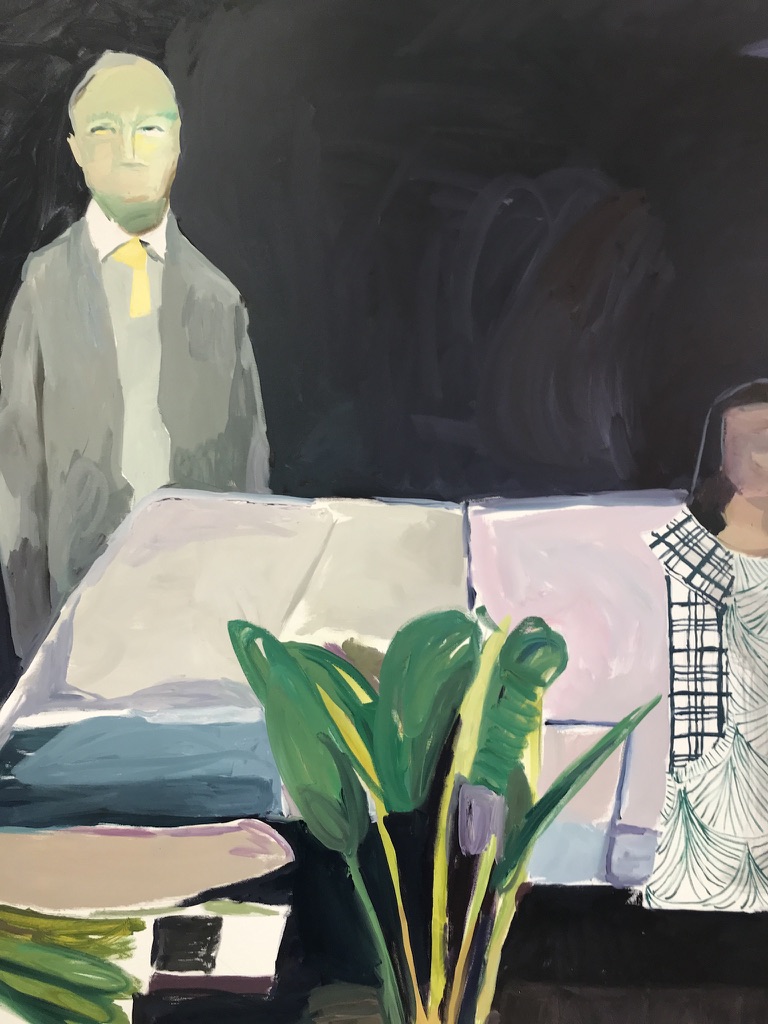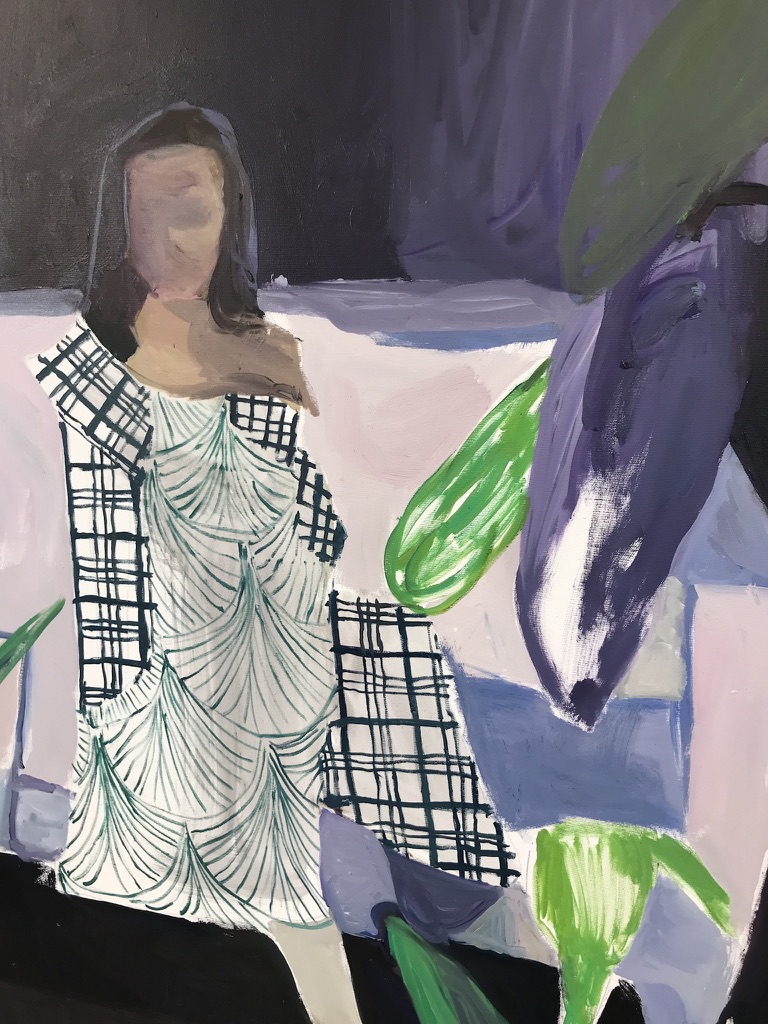Taking comfort
Helen Verhoeven at Gregor Podnar Gallery
Helen Verhoeven at Gregor Podnar Gallery
by Kathrin Heinrich
Writing about art for a living means that the perfect window to cover something is short; a small gallery show isn’t of much interest for publication after its brief run time. So, this is a text I usually don’t write, about a show I saw last November during a quick visit to the gallery but wasn’t able to review then. It popped up in conversations with Leonie a few times, so when she invited me to dis/claim #4 I took the opportunity to finally think about Humans on the page. My view of it is intertwined with my own exhaustion in dealing with pain and an economic reality in which I did not manage to see a lot of shows, or as many an art critic perhaps should – at least, not in person.
Is there solace in art? I’ve sat in many doctor’s offices and hospital rooms over the past months, and their unequivocal message seems to be: yes – and sometimes it is even for sale. I, too, was surprised when I first spotted a price tag in a waiting room, but there it was, below a subpar abstraction titled without a trace of irony: Never yours – 680€. While these artworks that I have had much time to study – often bemusedly so – range from the tastefully inoffensive to the outright brutally bad, they never relate to the situation at hand. They are clearly meant to take your mind off your sorrows and pains and transport you to a place far away. The places coming to mind when pondering them might be a church jumble sale or – should you be able to go private – pretensions to a blue-chip gallery complete with large-scale paintings and statement designer furniture. But it is never the cold harsh light of reality staring you back in the face. Thus, when I squeezed a visit to Helen Verhoeven’s show at Gregor Podnar Gallery into my ever-more crammed schedule of work and healthcare last fall, it was refreshing to see, for once, the reverse – to be confronted with the very situation of a treatment room.

Verhoeven zooms in on the therapy space, perhaps analysis as such, but it isn’t explicated. There might be a looming male figure, suit-clad, a specter of Freud – but in Vienna, it’s never clear how much is projection. A dark-haired woman, a patient perhaps, but will she talk? For the moment, she is mute. Or is it the other way around? Both are faceless, place holders. Now, months after my visit to the gallery, the memory of the paintings is hazy, and my imagination has filled in many of these intentional gaps left by the painter. I remember the warm gray reflective floor of the gallery, its stark white walls warmed by the yellow glow in the room, interspersed with cold light flooding in through the large glass door. Outside, it was crisp, a whiff of snow seemed to be in the air, a few leaves still blowing in the street, late fall or very early winter.
On the canvasses, lush dark greens, and dusty, muted lilacs and magentas, sky blue and lime yellow, steel and coal greys, deep coffee and black dominate Verhoeven’s paintings in her show titled Humans. The exhibition text informs me about her process, which makes use of Artificial Intelligence in generating motifs, though she morphs and layers upon them: “Verhoeven collaborates with chatbots to simulate situations (mostly therapy sessions and domestic engagements): ‘I asked it to fictionalize collaborations between me and other artists. For example, how I and some other artist would paint together, how we’d execute the imagined wishes of yet another person, like some dead psychologist or a writer. I then used AI image generators to visualize these imagined collaborations (…).’”

Now, I am considering these paintings through the images I took on my phone and online; mediation by screen, a reality that – in writing – we usually pretend doesn’t exist. Along the lines of Verhoeven’s notion of collaboration, my own snapshots shape my recollection of the select paintings I decided to document, where I zoomed in to capture texture and detail. What strikes me now is the insertion of graphic patterns, the faceless woman’s dress rendered in flat, broad strokes. The pastiche of flat planes collaged into the anonymous, blurred chamber-play scene of Oh, That Guy (2023). Browsing the gallery website, I become aware that there were also a few art historical motifs, like Judith II (2018) sitting limply on the beheaded Holofernes – but those weren’t part of my own memory.



Both the outsize greenery and the therapy setting remind me of Chantal Akerman’s A Couch in New York (1996). Something of an oddball romantic comedy, the movie places Juliette Binoche’s up-beat, wide-eyed dancer character in the apartment of a posh New York analyst, taking over his patients and plants, nurturing both to immense growth bordering on the ridiculous. In Verhoeven’s paintings, too, the lush plants tower over her scenes, looming large like non-human protagonists. “The social contract in therapy rests on some make-belief [sic]and role play, on trust, perception, deception, and invention,” states the exhibition text, and it is the carnivalesque doubling of this make-believe that lends A Couch in New York its wacky charm. The same un-seriousness shone through in Verhoeven’s therapyscapes, despite their heady conceptual grounding.

For all the talk of AI, artworks dealing in it usually seem so very uninteresting to me. In Humans, Verhoeven’s use of AI was obvious and invisible at once, and I liked just that about it. Furniture seemed to melt, slight distortions crept in, like the eponymous Man in Planter (2023) sitting misplaced amidst the greenery on a planter instead of a chair. Despite its alleged intelligence, AI tends to get things hilariously wrong, famously forever mangling human hands, for instance. In Verhoeven’s paintings, these glitches give a surreal air to her therapyscapes, dream-like and yet I didn’t find anything nightmarish about them. They rather suggested a comic moment; coupled with her lush hues, Verhoeven’s canvasses seemed to be imbued with a pure joy of color, rendering the generic motifs anything but bland.
They offered just enough blank space – sometimes literal, the raw canvas peeking through with visible pencil sketches – to insert myself into them, to imagine myself in her soft world, where couches, pillows, and plants reign. To imagine myself partaking in the make-believe and role play of the therapy setting in a more playful, more sensual way then my own medical appointments at the time had allowed for. But most of all, as cheesy as it sounds, they were simply able to spark a moment of imagination during weeks when I was just so damn tired. Although it probably wasn’t their objective, the paintings of Humans gave me a sense of quiet – yes, perhaps even of comfort. Would they have had the same effect in a medical setting? That I can only guess at – but for sure it’d be a meta level that current waiting room art can only dream of.
Helen Verhoeven Humans
Gregor Podnar Gallery, Vienna
October 26 – December 2, 2023
